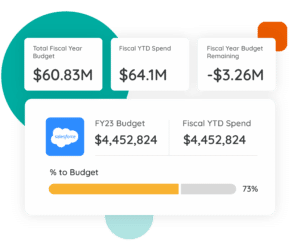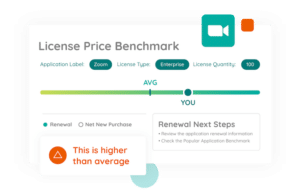Table of Contents
We’ve all had good ideas. Remember that toaster-coffee maker combo idea? Making your whole breakfast with the click of a button sounded pretty good. But then you thought about the logistics and cost, and it was more bother than it was worth.
Corporate innovation can be like that, too: great ideas implode without resources and a budget to execute.
According to McKinsey and Company, “In a business context, innovation is the ability to conceive, develop, deliver, and scale new products, services, processes, and business models for customers.”
Innovation ensures you stay competitive in the market, continue evolving to serve your customers’ needs, and improve your business operations.
To bring innovation to life, you must be able to fund it. In this blog, we’ll explain how to identify a budget for innovation at your organization. Then, we’ll explore how SaaS management can help free up room in your budget for new ideas and experiments.
How to Identify Budget for Innovation
Let’s start with some budgeting basics. Every company has to set an annual financial plan. The total cost structure and level of investment is based on your company’s top-line growth and operating margin objectives.
Budgeting starts with Horizon 1 objectives and priorities. These are the things we call KLO – keep the lights on. Or, what you need to achieve to keep the business afloat. That includes bringing on new customers, servicing your existing ones, delivering on features and functionality.

After that are your Horizon 2 and 3 priorities, which can be funded once Horizon 1 is achieved. You may know them by other names – big bets budget or transformation budget. This is where you need to identify budget for innovation.
Practically speaking, these budgets are wedged into the financial plan. That happens by challenging your Horizon 1 budget with efficiency and productivity targets vs. their current performance.
Your CFO and exec team deliver this plan to the business to then “go figure out”. In other words, make these big bets budgets work while still delivering on your Horizon 1 targets.
This is where software optimization comes into play. It allows budget owners to make that stretch target a reality. Otherwise, Horizon 2 and 3 investments get shoved out of the plan.
With that in mind, let’s talk about getting that budgetary freedom.
Software Optimization = Tangible Cost Savings
Software is most businesses’ second or third largest operating expense. That means there’s a lot of budget at play. And, inevitably, there’s wiggle room to create efficiencies and save money.
Where can you make the most impact for your innovation budget? There are four main cost-saving opportunities you need to look out for:
Consolidate duplicate subscriptions
If you get into the weeds of your SaaS stack, you will find multiple subscriptions for the same application. Hunt down these duplicate subscriptions and winnow them down. This is a great opportunity to look into enterprise agreements and leverage them for savings across your company.
Cancel unused and redundant applications
Blame it on shadow IT or inescapable software bloat. But the fact is, your SaaS stack has plenty of underutilized and/or completely redundant applications. This is one of the biggest opportunities to fund your innovation budget.
Finding ways to sustainably cut down these redundancies is key to cost savings. However, it doesn’t always mean trimming down each functionality to one app. Contrary to popular belief, some redundancy is ok. See where you can trim down redundancy versus where the redundancy is working.
Rightsizing licenses at renewal
Once your SaaS stack consists of the apps you actually need, you can focus on renewal. Rightsizing your licenses is one of two key aspects to cost savings at renewal. There are three key steps you should follow:
- Discover all SaaS throughout the organization. You can’t manage what you can’t see.
- Ideate, mapping trajectories toward company goals.
- Score and make recommendations. Look at your apps and decide which ones need how many licenses.

Negotiating better pricing
The other half of renewals is the price negotiation. This is where you specifically target pricing (be it per license or on an enterprise level) and negotiate the best deal for your enterprise.
Price benchmarks are a critical data point to have here. Knowing how your current price compares to similar organizations can be impactful leverage for reducing your contract value.
Advice from IT and Software Asset Management Leaders
You might want some advice from the budget people for all this budget talk; luckily, we’ve got just that. We’ve talked to plenty of Finance folks—including CIOs—on our SaaSMe Anything podcast, and we’ve compiled the best notes for innovation budgets.
Keith Sarbaugh, CIO at Zoetis
For Keith Sarbaugh, CIO at Zoetis, there’s one thing he focuses on: keeping costs low. On SaaSMe Unfiltered, he emphasized the need to manage costs aggressively so you can divert resources to difference-makers.
“Follow the money, get the base as low as you can possibly stand to get it,” he shared, “and then pour your investments into the things that are going to differentiate you in the market.”
Brad Pollard, CIO
Identifying optimization opportunities to fund your innovation budget is like finding a needle in a haystack. Brad Pollard, formerly CIO at Tenable, found such an opportunity with their phone service.
After seeing it underutilized in his SaaS management platform, Pollard evaluated a switch to a different app. And eventually, they changed vendors.
“We ended up staying flat on budget, not losing any functionality,” shared Pollard on the SaaSMe Unfiltered podcast. “And then we had money to do innovation, do new projects.”
Jason Owens, Sr. Director, Global ITAM at Salesforce
On SaaSMe Unfiltered, Jason Owens expressed the need for the entire organization to understand the transformative power of SaaS management.
“I think if we could get the story out to more people about how transformative software asset management, particularly in the SaaS space where people are just out swiping credit cards and agreeing to click through terms, that more people would say, ‘Oh, we really need to invest in this for our business because we can leverage that money and then unlock value and put it into things that are transformative for the business rather than just spend.’”
Identify Budget for Innovation, Driven by SaaS Cost Savings
We believe that 2024 will be the year of big bets. If you want to get in on the next wave of innovation – especially with the return of responsible business growth – free up your budget. Optimizing your software costs makes it all possible.
If you want help finding needles in your SaaS haystack, let Zylo help. We can show you how to identify and power your budget for innovation.

